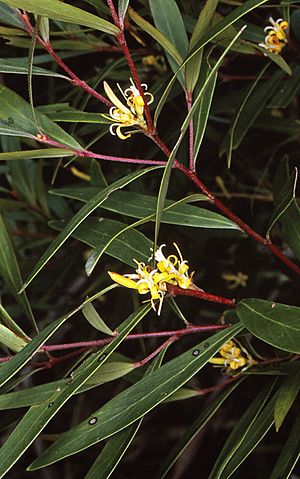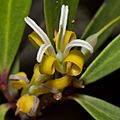Forest geebung facts for kids
Quick facts for kids Forest geebung |
|
|---|---|
 |
|
| Persoonia silvatica growing near Tantawangalo | |
| Scientific classification | |
| Genus: |
Persoonia
|
| Species: |
silvatica
|
The Forest Geebung, also known as Persoonia silvatica, is a special plant found only in south-eastern Australia. It belongs to the plant family called Proteaceae. This plant can be a shrub or a small tree. It has leaves shaped a bit like a spear and pretty yellow flowers with white centers. You can mostly find it growing in forests near the border of New South Wales and Victoria.
Contents
What Does the Forest Geebung Look Like?
The Forest Geebung is a shrub or a small tree. It can grow from 1.5–9 m (5–30 ft) tall. Its young branches have a few hairs on them.
Leaves
The leaves grow one after another along the stem. They are 30–120 mm (1–5 in) long and 6–25 mm (0.2–1 in) wide. Their shape is like a narrow oval or a spear, with the narrower part near the stem. The leaves are flat and smooth. The top side is darker than the bottom. When they are young, the leaves are a bit hairy, but they become smooth as they get older.
Flowers
The flowers grow in small groups called racemes. These groups can be found where a leaf joins the stem, or at the very ends of the branches. Sometimes, these flower groups keep growing into new leafy shoots. Each flower sits on a tiny stalk called a pedicel, which is 1–4 mm (0.04–0.2 in) long and sometimes hairy.
The flower has four yellow parts called tepals, which are 12–14 mm (0.5–0.6 in) long. They are joined at the bottom, but their tips curl back. Each tepal has a small spine, up to 1.5 mm (0.06 in) long, at its end. In the middle of the flower, there's a central style. It's surrounded by four white anthers. These anthers are also joined at the bottom and have tips that curl back. If you look at them from the end, they look like a cross! The part of the flower that holds the seeds, called the ovary, is smooth.
Fruit
Forest Geebungs flower in summer. After flowering, they produce green, oval-shaped fruits called drupes. These fruits are about 15 mm (0.6 in) long and 12 mm (0.5 in) wide.
How the Forest Geebung Got Its Name
The scientific name for this plant, Persoonia silvatica, was first officially described in 1957. A botanist named Lawrie Johnson gave it this name. He used plant samples collected by Ernst Betche in 1893 at Brown Mountain in New South Wales.
The second part of its scientific name, silvatica, comes from a Latin word. It means "of woods" or "from the forest," which makes sense because this plant grows in forests!
Where Does the Forest Geebung Live?
The Forest Geebung grows in mountain forests along the Great Dividing Range. You can find it in East Gippsland in Victoria and in south-eastern New South Wales. Some specific places where it grows include Bendoc, the Errinundra Plateau, Mount Kaye, and Howe Hill in Victoria. In New South Wales, it's found in places like Monga, Tinderry Peak, and Mount Currockbilly.
Sometimes, you might find plants that are a mix of the Forest Geebung and another type of geebung called Persoonia confertiflora. These mixed plants have been seen near Genoa in Victoria.
Images for kids
-
Leaves and fruit
Errinundra National Park



